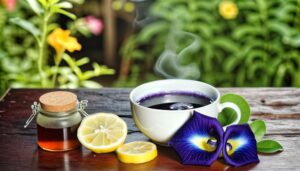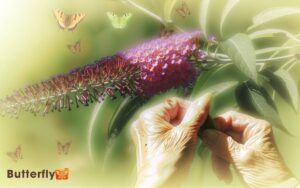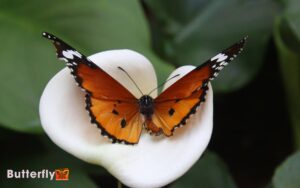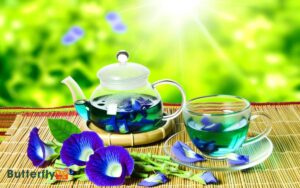Do You Care for a Butterfly in Winter?
In winter, proper care for a butterfly entails accurate species identification to dictate specific needs. Assess its physical state, evaluating wing integrity, body weight, and disease signs.
Construct an overwintering habitat replicating natural conditions with controlled temperature (55-65°F) and humidity (60-80%), using materials like bark and leaves for shelter. Provide nutrition through 10% sugar solutions and fresh fruits, ensuring hydration.
Regularly monitor and adjust care strategies, checking for desiccation or mold. Gradual acclimation to outdoor conditions as spring approaches is crucial for survival.
By understanding these detailed steps, further insights into butterfly conservation and adaptation can be gained.

Key Takeaways
- Accurately identify the butterfly species to determine specific winter care needs.
- Create a controlled winter habitat with appropriate temperature and humidity levels.
- Regularly assess the butterfly's health, checking for wing integrity and nutritional status.
- Provide nutrition through sugar solutions and fresh fruits to sustain energy.
Identify the Butterfly Species
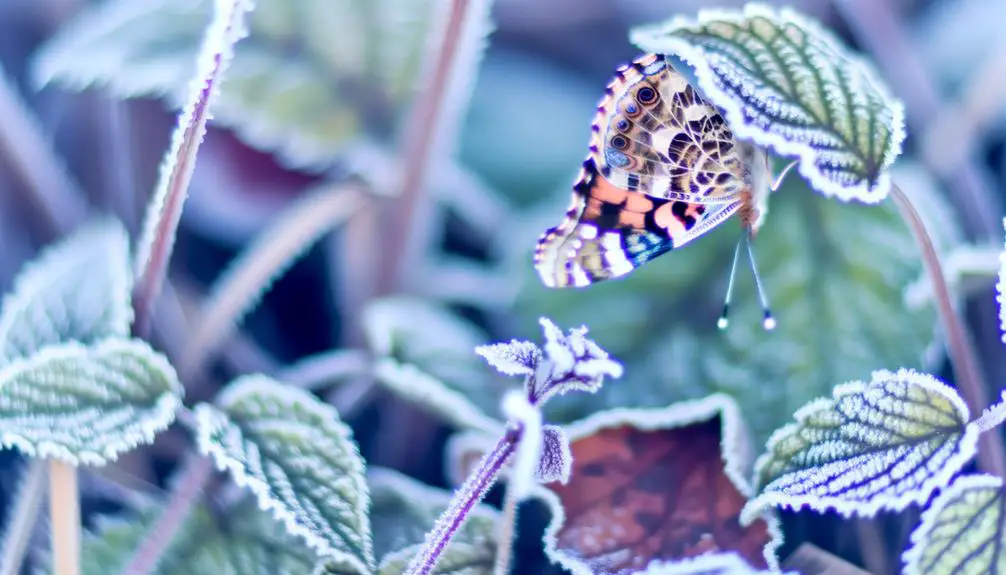
Accurate identification of the butterfly species is essential for determining the appropriate measures to protect and care for them during the winter months.
Differentiation between species such as Vanessa atalanta (Red Admiral) and Nymphalis antiopa (Mourning Cloak) can be achieved through careful examination of wing patterns, coloration, and body morphology.
Utilizing dichotomous keys and field guides, researchers can discern specific traits, such as the distinctive red bands of the Red Admiral or the dark, velvety wings with yellow borders of the Mourning Cloak.
Genetic analysis via DNA barcoding also provides precise species confirmation.
Correct identification informs conservation strategies, as some species enter diapause, a dormancy state, while others migrate to warmer climates, necessitating different care protocols.
Assess the Butterfly's Condition
To determine the appropriate care for a butterfly during the winter months, it is crucial to assess its physical condition, including wing integrity, body weight, and overall health.
Inspect the wings for any tears, fraying, or deformities, as these can impede flight and feeding.
Evaluate body weight by gently palpating the abdomen; a butterfly with a desiccated or underweight abdomen may require immediate nutritional support.
Additionally, observe for signs of disease, such as discolored spots or unusual lethargy, which could indicate fungal or bacterial infections.
Document these observations meticulously, as they will guide subsequent care strategies.
Understanding the butterfly’s physiological status is essential to guarantee its survival through the harsh winter conditions. Scientists study factors like metabolism and fat reserves to determine how well a butterfly can endure cold temperatures. Some species enter a state of diapause, slowing their bodily functions to conserve energy until warmer weather returns. However, others with the shortest lifespan of a butterfly do not live long enough to experience seasonal changes, perishing shortly after reproduction.
Create a Suitable Habitat
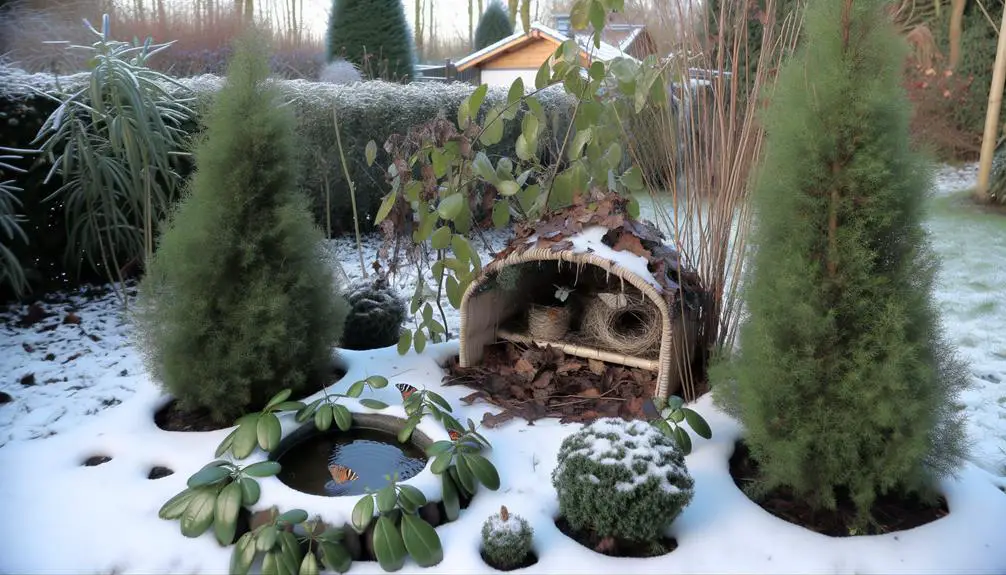
Establishing an appropriate winter habitat for a butterfly involves replicating its natural environment as closely as possible to guarantee ideal conditions for survival.
Research indicates that a controlled environment with specific temperature and humidity levels is essential. A terrarium or butterfly house, equipped with a hygrometer and thermostat, can help maintain ideal parameters.
Structural elements such as bark, leaves, and twigs mimic natural hiding spots, providing necessary shelter. Additionally, ensuring the habitat is free from predators and disturbances is critical.
Observational studies show that butterflies thrive in environments where they can enter diapause, a state of suspended development, thereby conserving energy.
Provide Proper Nutrition
To guarantee the survival of butterflies during winter, it is essential to provide proper nutrition through scientifically validated methods.
Offering sugar solutions mimicking natural nectar can supply important carbohydrates, while fresh fruits like oranges and bananas can provide critical vitamins and minerals.
Additionally, maintaining access to clean water is imperative to prevent dehydration and support metabolic processes.
Offer Sugar Solutions
Ensuring butterflies receive adequate nutrition during winter can be achieved by offering them sugar solutions, which mimic the nectar they naturally consume. Research indicates that a 10% sugar solution is ideal for butterfly sustenance. This concentration provides the necessary carbohydrates while avoiding hyperglycemia risks.
| Solution Concentration | Observed Effects |
|---|---|
| 5% | Insufficient energy |
| 10% | Ideal nutrition |
| 15% | Potential dehydration |
Field observations reveal that butterflies notably prefer the 10% solution, demonstrating increased feeding activity and prolonged lifespan. The solution can be easily prepared by dissolving one part sugar in nine parts water. It is essential to refresh the solution regularly to prevent fermentation and mold growth, ensuring a safe feeding environment.
Provide Fresh Fruits
Regularly providing fresh fruits such as oranges, bananas, and apples can greatly enhance the nutritional intake of butterflies during the winter months.
These fruits contain essential nutrients and sugars that are crucial for the metabolic processes of butterflies, especially when natural nectar sources are scarce.
Research indicates that the high fructose content in bananas provides a quick energy boost, while oranges offer vitamin C, which can support immune function.
Apples, with their balanced sugar composition, serve as a sustained energy source.
Detailed observations show that butterflies frequently engage in proboscis extension behavior when exposed to these fruits, indicating successful nutrient uptake.
Consequently, incorporating fresh fruits into their diet is a scientifically-backed method to guarantee their health and well-being during colder periods.
Ensure Clean Water
In addition to providing fresh fruits, maintaining access to clean water is crucial for supporting the hydration and overall health of butterflies during winter.
Butterflies primarily obtain water through nectar; however, supplementary water sources are necessary during colder months when nectar availability decreases. Research indicates that butterflies require moisture for metabolic processes and thermoregulation.
Verify water is free from contaminants and regularly refreshed to prevent bacterial growth. Shallow water dishes with pebbles or sponges can provide safe drinking spots, minimizing the risk of drowning.
Incorporating a mixture of water and dissolved minerals replicates natural sources, contributing to the butterflies' nutritional needs. Monitoring water intake and quality can greatly enhance the survival and health of overwintering butterflies.
Ensure Safe Shelter
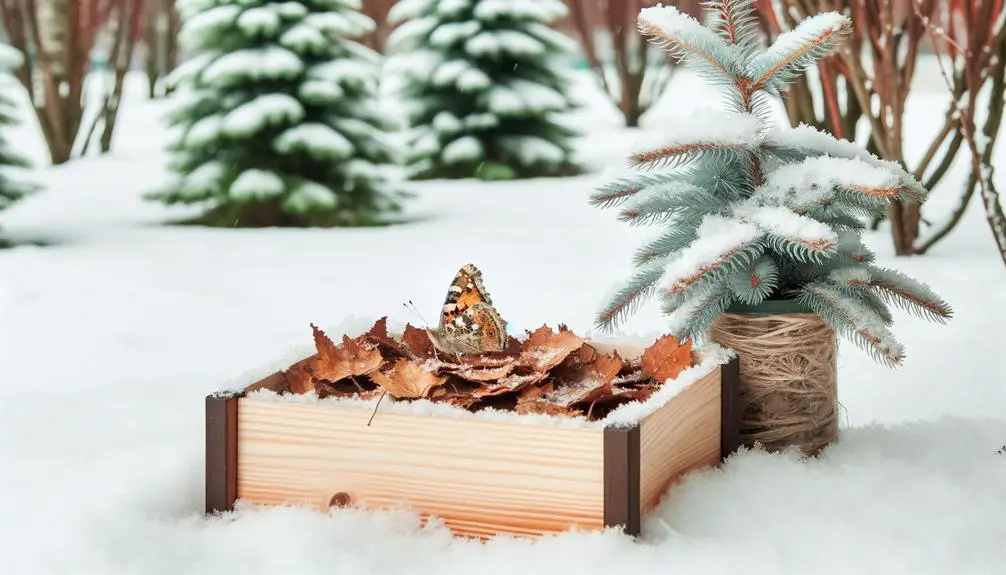
Ensuring safe shelter for butterflies during winter involves creating an appropriate indoor habitat and providing natural hideaways.
Studies indicate that an indoor environment with controlled temperature and humidity can considerably improve overwintering survival rates.
Additionally, incorporating natural elements such as leaves and branches can mimic the butterfly's natural habitat, offering essential protection from environmental stressors.
Indoor Habitat Preparation
Constructing an ideal indoor habitat for a butterfly during winter involves meticulous attention to environmental parameters such as temperature, humidity, and light exposure to simulate its natural overwintering conditions.
The best temperature range is typically between 50-60°F (10-15°C), ensuring metabolic processes occur without inducing stress. Relative humidity should be maintained around 60-70% to prevent desiccation.
Light exposure must mimic natural daylight cycles, employing full-spectrum LED lights to replicate the photoperiod. Research indicates that consistent photoperiods help maintain circadian rhythms, crucial for physiological stability.
Additionally, airflow must be regulated to prevent fungal growth while providing adequate oxygenation. Such controlled conditions are essential for the butterfly's survival through winter, aligning closely with its ecological requirements.
Provide Natural Hideaways
Creating natural hideaways within the indoor habitat is essential for providing butterflies with safe, secure shelter during winter.
Research indicates that butterflies require microhabitats mimicking their natural environments to enter diapause effectively. Detailed observations reveal that incorporating elements such as leaf litter, bark, and small branches can greatly enhance their survival rates. These materials offer insulation and mimic the crevices and foliage butterflies utilize in the wild.
Studies suggest that maintaining a stable microclimate with moderate humidity levels and minimal temperature fluctuations is vital. Additionally, positioning these hideaways in shaded, undisturbed areas of the habitat minimizes stress and predation risks.
Employing these scientifically-grounded strategies guarantees a conducive environment for overwintering butterflies, fostering their health and longevity.
Monitor and Care Regularly
Regularly monitoring the butterfly's enclosure for temperature and humidity levels is crucial to guaranteeing its survival through the colder months. Ideal thermal conditions should be maintained between 55-65°F, mimicking natural overwintering environments.
Employ a calibrated hygrometer to confirm humidity remains within a 60-80% range. Consistent data logging will help detect any deviations that could compromise the butterfly's well-being.
Observationally, inspect for signs of desiccation or mold growth on the butterfly and its surrounding habitat. Adjust environmental controls accordingly, utilizing misting systems or dehumidifiers.
Nutritional care remains essential; provide fresh, sugar-water solutions or specialized nectar substitutes to sustain metabolic functions. Regular check-ups, at least bi-weekly, will facilitate early detection of potential health issues.
Prepare for Spring Release
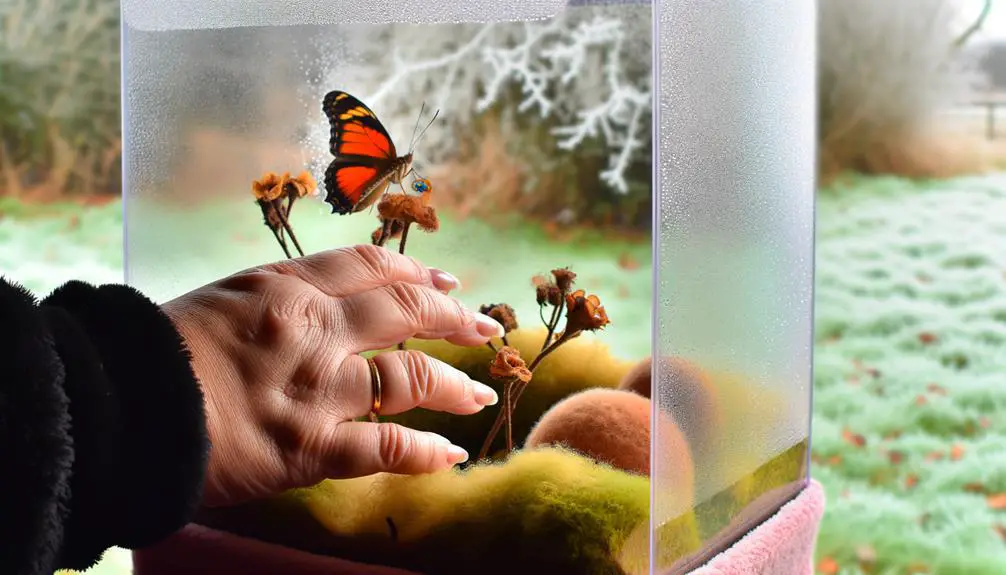
As winter wanes and temperatures begin to rise, it is imperative to gradually acclimate the butterfly to outdoor conditions to guarantee a successful spring release. This process involves simulating natural environmental changes within a controlled indoor setting. Progressive exposure to increased light and temperature variations is essential for the butterfly's physiological adaptations.
| Step | Description |
|---|---|
| Initial Exposure | Introduce the butterfly to indirect sunlight for short periods |
| Temperature Control | Gradually increase ambient temperature to mimic spring |
| Nutritional Support | Provide nectar-rich flowers and supplements |
| Final Release | Choose a mild, windless day for the butterfly's outdoor release |
Research underscores the importance of this methodical approach in ensuring the butterfly's survival and effective reintegration into its natural habitat, thereby promoting biodiversity.
Conclusion
To summarize, effective winter care for butterflies necessitates species identification, condition assessment, habitat creation, nutritional provision, secure sheltering, regular monitoring, and preparation for spring release.
Significantly, approximately 90% of butterfly species undergo diapause in various life stages, highlighting the importance of tailored care strategies.
Research underscores the requirement of mimicking natural environments to guarantee survival, thereby emphasizing the critical role of scientific intervention in the conservation efforts for these essential pollinators during the harsh winter months.

